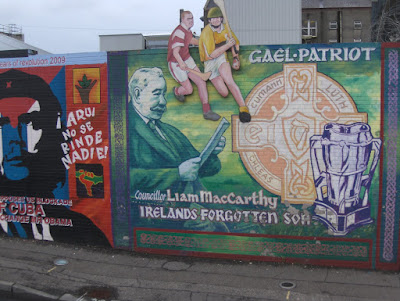I hate it when the cows come into the convenience store!
Monday, September 14, 2009
Sunday, September 13, 2009
Modern Belfast
The Beacon of Hope

The Apple Store

The Belfast Wheel

The Port of Belfast

The Odyssey, Entertainment Center

Victoria Square






For more information about Belfast, see:
Welcome to the official site of the Belfast Visitor & Convention Bureau and the Belfast Welcome Centre and Belfast Tourist Information Centres winners of the Northern Ireland Tourist Board 2009 Tourist Information Centres of the Year. Whether you are visiting as a business traveller, a family group or a day tripper here for the shopping, we have something to tempt you.

The Apple Store

The Belfast Wheel

The Port of Belfast

The Odyssey, Entertainment Center

Victoria Square






For more information about Belfast, see:
Welcome to the official site of the Belfast Visitor & Convention Bureau and the Belfast Welcome Centre and Belfast Tourist Information Centres winners of the Northern Ireland Tourist Board 2009 Tourist Information Centres of the Year. Whether you are visiting as a business traveller, a family group or a day tripper here for the shopping, we have something to tempt you.
Historic Belfast
City Hall, Seat of Government for Belfast



Stormont, Seat of Government for Northern Ireland


The Crown Bar

St. Anne's Church

Queen's University




Stormont, Seat of Government for Northern Ireland


The Crown Bar

St. Anne's Church

Queen's University

Kilmainham Gaol, Dublin, Ireland
The history of Kilmainham Gaol dates back to 1787, but the infamous jail that sits on the site today as a museum was opened in 1796, four years before the Act of Union abolished the Irish Parliament in Dublin (and thus making Ireland a part of the United Kingdom of Great Britain). "It closed in 1924, two years after the signing of a Treaty that restored a measure of independence to the south of Ireland, a step that led ultimately to the declaration of a Republic in 1949.
Thus, the opening and closing of the Jail more or less coincided with the making and breaking of the Union between Great Britain and Ireland. During the intervening years the Jail held a mirror to the turbulent history of the troubled relations between the two countries. These years saw Rebellion, Famine, Revolution, and Civil War. At the heart of these troubles lay Irish attempts at varying degrees of self-determination which came to a terrible climax in the years 1916-23."






"The Jail is now a National Monument, and has been opened to the public as a Museum. The Museum tells the story of Ireland's troubled path to independence and of the Jail's role in that story."




Many of Ireland's most important historical figures spent time in the jail, and some of them died there by firing squad or by the hangman's noose. The leaders of the 1916 Easter Rising were held and executed here.
"There can be no doubt that the response of the British government to the Rising contributed measurably to the further alienation of Irish public opinion. On 26th April 1916, it had introduced martial law and next day appointed Major-General Sir John Maxwell as Commander-in-Chief of troops, Ireland. He had full authority to restore order, put down the rebellion, and punish its participants. Maxwell never doubted that its leaders should be court-martialled and those most prominent executed... In 90 cases the court’s verdict was ‘Death by being shot’. Maxwell confirmed this judgement on 15 defendants, and these were executed between 3-12 May 1916."


There can be few places, therefore, that more intensely focus the forces that shaped modern Irish history than Kilmainham Jail.
Thanks to the following:
Kilmainham Gaol
Kilmainham Gaol (Irish: Príosún Chill Mhaighneann)
The Executions of the Leaders of the 1916 Easter Rising
Thus, the opening and closing of the Jail more or less coincided with the making and breaking of the Union between Great Britain and Ireland. During the intervening years the Jail held a mirror to the turbulent history of the troubled relations between the two countries. These years saw Rebellion, Famine, Revolution, and Civil War. At the heart of these troubles lay Irish attempts at varying degrees of self-determination which came to a terrible climax in the years 1916-23."






"The Jail is now a National Monument, and has been opened to the public as a Museum. The Museum tells the story of Ireland's troubled path to independence and of the Jail's role in that story."




Many of Ireland's most important historical figures spent time in the jail, and some of them died there by firing squad or by the hangman's noose. The leaders of the 1916 Easter Rising were held and executed here.
"There can be no doubt that the response of the British government to the Rising contributed measurably to the further alienation of Irish public opinion. On 26th April 1916, it had introduced martial law and next day appointed Major-General Sir John Maxwell as Commander-in-Chief of troops, Ireland. He had full authority to restore order, put down the rebellion, and punish its participants. Maxwell never doubted that its leaders should be court-martialled and those most prominent executed... In 90 cases the court’s verdict was ‘Death by being shot’. Maxwell confirmed this judgement on 15 defendants, and these were executed between 3-12 May 1916."


There can be few places, therefore, that more intensely focus the forces that shaped modern Irish history than Kilmainham Jail.
Thanks to the following:
Kilmainham Gaol
Kilmainham Gaol (Irish: Príosún Chill Mhaighneann)
The Executions of the Leaders of the 1916 Easter Rising
Subscribe to:
Comments (Atom)









